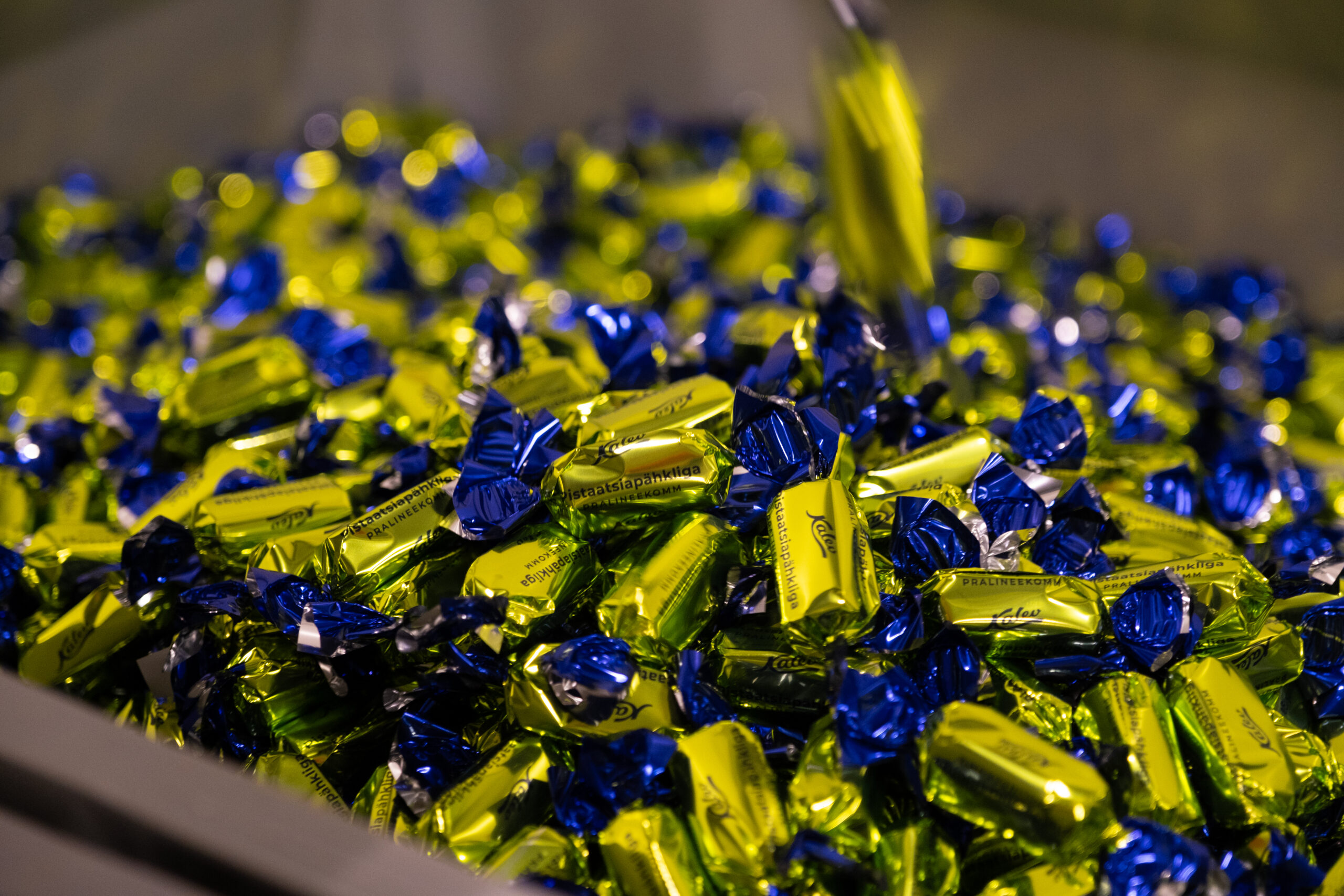
How are Kalev sweets made?
Kalev’s world of sweets is abundant and delicious! In order for our passion for confectionery to continue from generation to generation, we also actively contribute to making our products and production sustainable and environmentally friendly.
Read more about how and where our chocolates and sweets are made, and how to try your hand at making sweets yourself. In addition, we have created a variety of appetising recipes to make sweet and savoury delicacies from our products.
Raw materials for chocolate
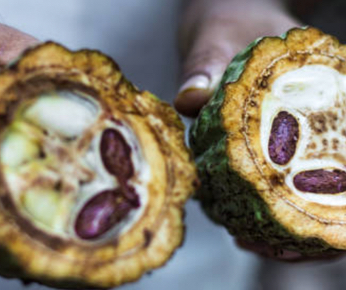
The main raw material for chocolate is high-quality cocoa
Cocoa is the main and most important ingredient for chocolate. Cocoa trees grow only in a narrow area on either side of the equator in countries whose inhabitants are facing difficult economic and social conditions on a daily basis. This is why Kalev considers it important to focus on sustainable and responsible cocoa farming, and in turn improving the working and living conditions of cocoa farmers.
In 2014, Kalev joined UTZ Certified, the world’s leading programme in supporting responsible and sustainable coffee, tea and cocoa farming. Since 2017, all of the cocoa required for making Kalev chocolate is certified, and all of our chocolate products have the right to use the UTZ Certified label. This label on the product indicates that the company supports responsible cocoa farming. By buying products with the UTZ label, you are also supporting that principle.
In 2022, the UTZ label was replaced by the Rainforest Alliance label as a result of the merger of the two organisations – UTZ and Rainforest Alliance.
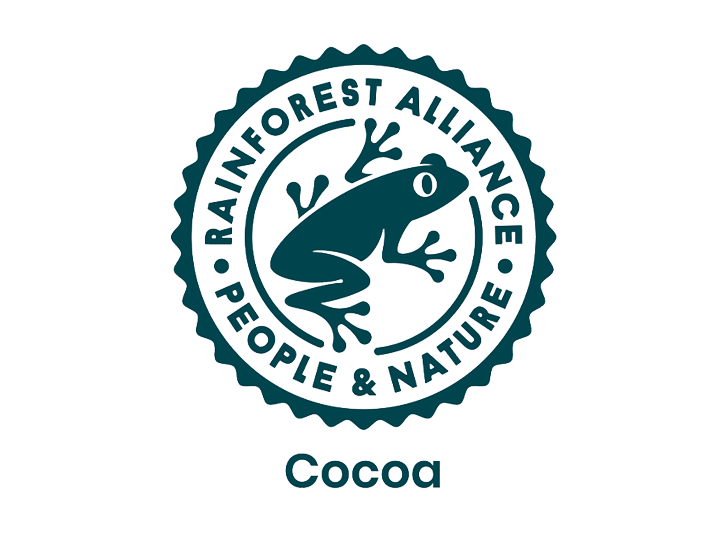
The Rainforest Alliance logo means that the corresponding cocoa has been grown taking into account more sustainable agricultural practices. More information about the Rainforest Alliance can be found on their website:
When you choose Rainforest Alliance Certified Cocoa as a consumer, you support farmers who take care of the well-being of their employees and our natural resources.
The history of chocolate and marzipan
Chocolate
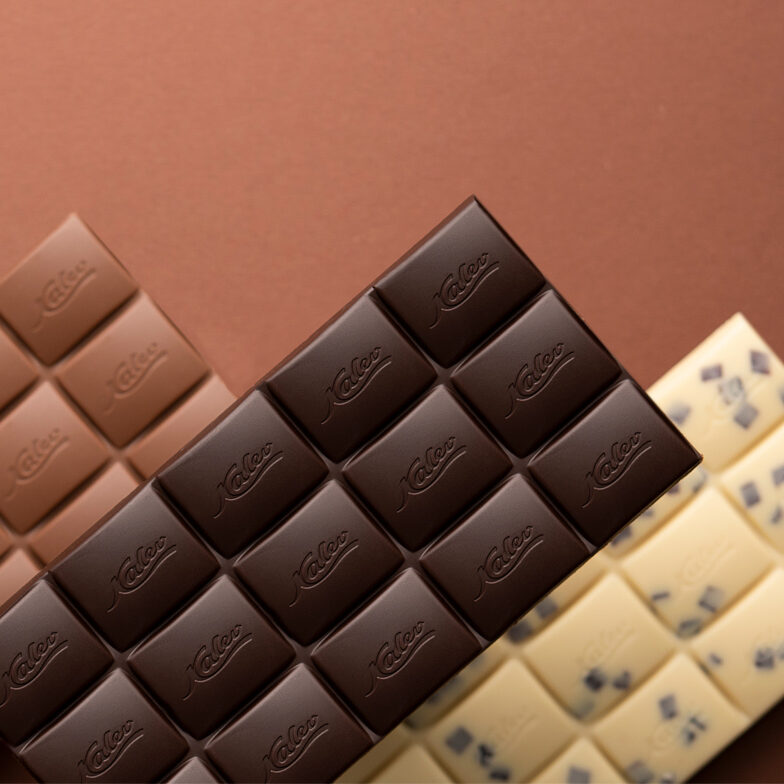
Chocolate is a sweet treat that has been known for thousands of years. Today, chocolate is made from cocoa mass and cocoa butter, which are made from roasted cocoa beans, and sugar. In the case of milk chocolate, milk is also added to the mix.
A confection can only allowed to be referred to as chocolate if it has been made from cocoa butter. It can contain up to 5% of other vegetable fat (and even that must have identical properties to cocoa butter).
Originally, chocolate was a cold drink made from roasted, ground and frothed cocoa mass, and did not contain sugar, which is why its creators, the Aztecs in Central America, referred to it as xocolatl (bitter water).
Chocolate became known in Europe following the voyages of Columbus to America, and after the Spaniard Cortez conquered Mexico in the early 16th century. Solid chocolate as we know it was first manufactured by Joseph Fry of the Fry & Sons company in the middle of the 19th century. In 1875, the Swiss Daniel Peter added milk to chocolate, thereby creating milk chocolate.
In Estonia, one of the first renowned chocolate manufacturers, and predecessor of Kalev confectionery company, was Georg Stude’s company in Tallinn during the second half of the 19th century.
Main types of chocolate
Nowadays, there are several different types of chocolate available in the shops. The differences start with the country of origin of the cocoa beans, and become more pronounced depending on the production method and recipes used to make the chocolate.
Dark chocolate
The cocoa content in dark chocolate can even be over 90%. This type of chocolate is the most beneficial to your health, mainly thanks to its high cocoa content. Dark chocolate mainly consists of cocoa mass, cocoa butter, sugar and lecithin. The depth of the colour of the chocolate and the bitterness of its flavour depend on the ratio of cocoa mass to sugar. Semi-sweet dark chocolate with a cocoa content of up to 50% is usually used in pastries.
Milk chocolate
In milk chocolate, some of the dry cocoa mass has been substituted with milk components, which gives a sweeter flavour, lighter colour and softer structure to the chocolate. As it is extremely heat-sensitive, using milk chocolate in desserts that require heat-processing is more complicated. It is also great for making decorations as a nice alternative to dark chocolate, in terms of its aroma, flavour and colour.
White chocolate
The manufacturing process and ingredients of white chocolate are similar to that of ordinary chocolate, with one important exception: no cocoa mass or powder is used in white chocolate. The only cocoa product in white chocolate is cocoa butter. That is why white chocolate is sweeter than other types of chocolate, and is also great for making desserts. Compared to regular chocolate, it contains a lot more milk. However, melting white chocolate requires extra care: heating it too quickly may cause it to become grainy, or even to burn.
The Story of Marzipan
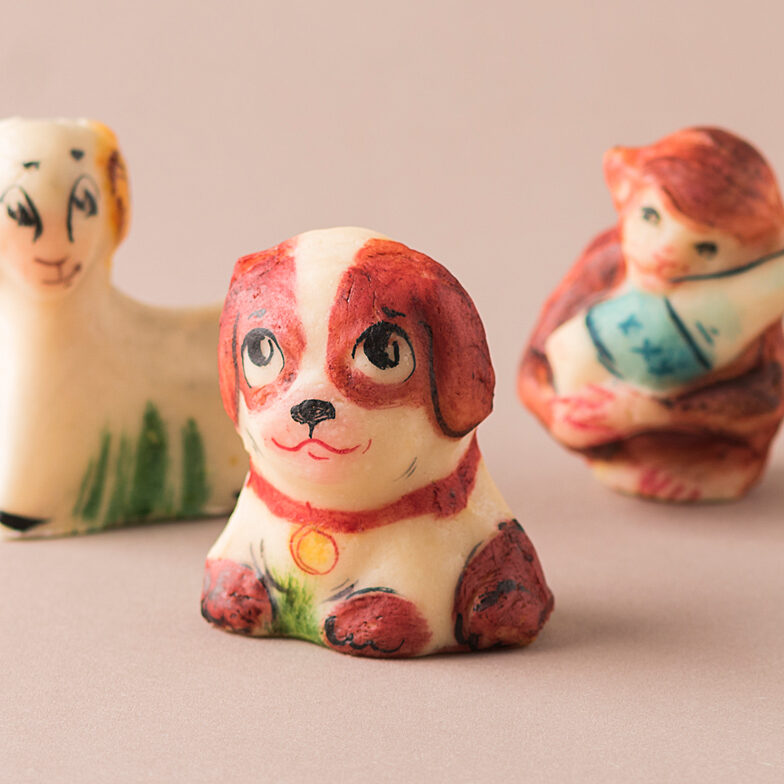
Made mostly of almonds and icing sugar, marzipan is one of the oldest sweets manufactured in Estonia, with production dating back to the Middle Ages. Marzipan probably originated from Persia (modern-day Iran), where written sources first mentioned this sweet treat in the 9th century. In the Early Middle Ages, marzipan reached Europe, where the old Hanseatic towns of Reval (now known as Tallinn) and Lübeck started manufacturing it almost simultaneously.
In Estonia, marzipan was first produced by pharmacists. More specifically, at the Town Hall Pharmacy of Tallinn, the oldest continuously-operating pharmacy in Europe, it is first mentioned in written records in 1422. According to a popular local legend, marzipan was invented by an assistant of the above-mentioned pharmacy.
This legend became particularly famous thanks to the popular book Mardileib (Mart’s Bread) by the Estonian novelist Jaan Kross. In pharmacy documents dating from 1695, we can find a marzipan medicine under the name Panis Martius (also Marci Panis).
During the Hanseatic period, sugar bakers, known as confectioners since the 18th century, began making marzipan. One of them, Lorenz Cavietzel, a Swiss confectioner of the Third Guild, made his mark in history by purchasing a property on Pikk Street in Tallinn’s Old Town, where the current Maiasmokk Café is located. In the early 19th century, he started making marzipan there, among other sweets. This is considered the birth of both Estonia’s confectionery industry and the oldest predecessor of the Kalev candy factory.
The marzipan and chocolate factory established at the same location became even more famous in the second half of the 19th century, when Georg Johann Stude, a Baltic German from Narva, rebuilt the building and expanded it by purchasing the neighbouring plot.
Another preserved document is a 17th-century order made by the above-mentioned pharmacy for the renowned Dutch sculptor Arent Passer to make two stone marzipan moulds. One of these moulds depicted Tallinn’s large coat of arms with a lion, and the other depicted a small coat of arms with a cross.
Both of these were regarded as highly suitable moulds for gifts sent by the pharmacy to the aldermen on various special occasions.
Georg Stude’s exclusive marzipan products were well-known in the Governorates of Estonia and Livonia, and were also supplied to the Russian Imperial Court in St. Petersburg. Until the start of World War I, Georg Stude’s sweets were also sold in a company store in Moscow. Over the twisted course of history, Georg Stude’s company was nationalised but, fortunately, the manufacturing of marzipan figurines did not stop. Their production later continued in Estonia’s largest confectionery company, Kalev. The marzipan fruit and vegetables, animal and bird figurines, marzipan cakes and postcards with city views soon also found favour among the Kremlin’s “uncrowned rulers”. Leonid Brezhnev appreciated them particularly highly.
The very same methods and antique marzipan moulds from Stude’s store, dating back to the late 19th and early 20th century, are used to make marzipan figurines at the Maiasmokk building to this day (approx. 200 historical marzipan moulds have been preserved). All the figurines are shaped by hand, and later painted using a brush and food colouring. That adds a piece of the artist’s soul to every figurine, thereby making it unique.
Why is dark chocolate good for you?
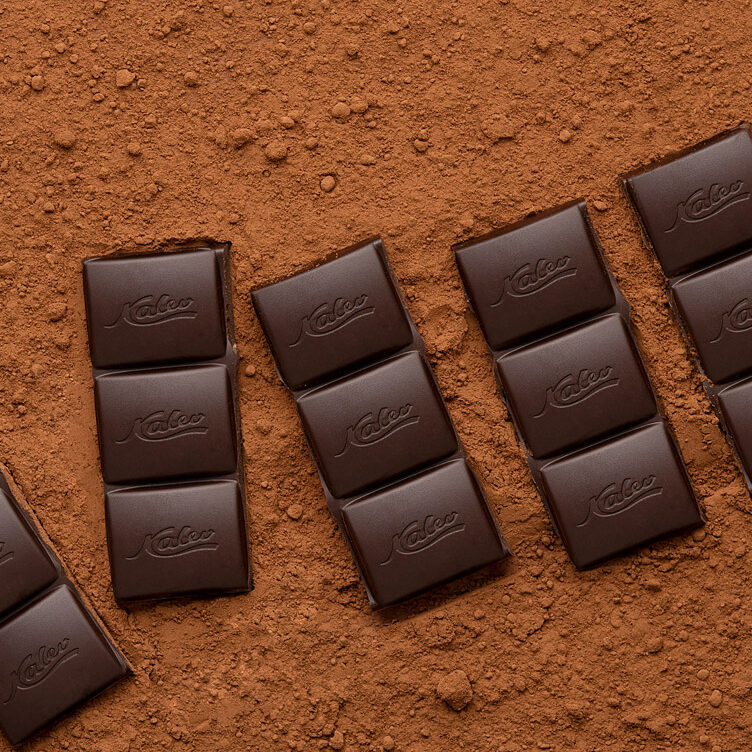
Scientists have studied chocolate extensively and proved that many of its characteristics are good for your health. Meanwhile, we must not forget that it is particularly dark chocolate, i.e. chocolate with a high cocoa content, which is most beneficial.
It is an antioxidant called flavonol epicatechin that has the most magical effect in chocolate. This affects the cell’s “powerhouse” – the mitochondria. According to Francisco Villarreal, Professor of Biomedicine at the University of California (2012), their well-being helps in the prevention of many diseases, such as Alzheimer’s.
Heart and blood pressure
Based on research German scientists confirm that dark chocolate helps to lower high blood pressure by having a relaxing effect on the cells of the blood vessel walls. As a result, the vascular lumen expands and hypertension decreases (Desch, S. et al., 2010). An international study led by Swiss researchers found that dark chocolate also has a widening effect on the heart’s blood vessels (coronary arteries) (Flammer, A. et al., 2007).
The relaxing effects of dark chocolate flavonoids on blood vessels have been also recognised by other researchers. Australian researchers led by Dr Karin Ried (2012) have concluded from 15 studies that consuming dark chocolate for at least 14 days lowers high blood pressure by an average of 5 mmHg. This can reduce the risk of heart disease by up to 20%.
Dark chocolate contains flavonoid catechins, which are antioxidants and help to strengthen the walls of the heart and blood vessels and protect body cells from the harmful effects of free radicals. In tests on animals American scientists (Vinson et al., 2006) found that catechins inhibit atherosclerosis and lower cholesterol. So therefore, chocolate can have a positive effect in preventing heart disease.
A research team led by Steve Atkin, Professor of Diabetes and Endocrinology at Hull University, England recommends eating dark chocolate for type 2 diabetes to prevent heart disease, since it helps to keep fluctuating blood sugar levels stable (2010).
Brain and thinking
The flavonoid epicatechin in chocolate helps maintain brain cells by stimulating blood flow to the capillaries and helping in the formation of new capillaries. This has been studied, for example, by Astrid Nehling, a French doctor in physiology and neurochemistry. According to her research, dark chocolate helps to prevent brain degenerative changes in the elderly and keep the memory fresh, but it is not clear from what age it should be eaten regularly (2012).
Body weight
Professor Eric Ding (2012) summarised 24 studies at a conference of the American Society of Chemists in San Diego, which concluded that cocoa flavonoids in chocolate do not alter body mass index in case of moderate consumption of chocolate. However, if you eat large quantities you run the risk of it giving you too much energy.
Mood
Chocolate helps prevent stress and improves your mood by stimulating the production of the “happy” hormone endorphin. Dr Astrid Nehling (2012), who has researched cocoa flavonoids, writes that eating chocolate also increases your sense of well-being.
Consumption
According to the Estonian Food Recommendations (2006), the daily limit for sweets is 2 to 4 servings, with 1 serving being 10 g of chocolate or 2 teaspoons of sugar, honey or jam. Thus, in order for dark chocolate to have a healthy and beneficial effect on the body, you should eat an average of 3 pieces of dark chocolate a day.
Confectionery Workshop
The premises of Kalev Chocolate Shop in the Rotermann Quarter also include a Confectionery Workshop where all sweet lovers and those seeking new experiences can try making confectioneries themselves. You can make different kinds of chocolates or paint marzipan figurines.
Join us and let’s make sweets together!
The workshop is perfect for celebrating children’s birthday parties or hosting smaller events. It is also possible to rent the facilities of the workshop for events. Come and prepare a sweet surprise with us!
Marzipan painting
Did you know that all Kalev marzipan figures are handmade and made using techniques and molds that have been used for centuries? Come and see what it means to make one figure and feel like a real master. During the workshop, marzipan and figure making will be introduced, colors used for marzipan painting will be mixed and painted. Each participant can paint one figure of about 100g exactly as they wish. It is a fun and enjoyable experience to have with friends or colleagues.
Prices
- Group up to 30 people 30 € / participant
- Non-participating guest: 5 €
Prices include VAT.
The price includes marzipan making, painting instruction, on-site tools (apron, brush, colors), one marzipan figure weighing about 100g and drinking water. The workshop lasts 2 hours.
Discount for kindergarten and school groups
For school and kindergarten groups, we give a Kalev Chocolate Shop -10% discount coupon, which is valid for the following week after the workshop.
Candy making
In Kalev chocolate shops you will find a wide selection of delicacies made by hand by a confectioner. Come and learn to surprise your loved ones with something special – chocolates and sweets made by yourself. You too can become a master!
During the workshop, the basics, raw materials and techniques of chocolate candy making will be introduced. Each participant can make up to 8 different chocolate candies and enjoy them on site or take them away in a nice gift box.
Prices
- Group up to 24 people 40 € / participant
- Non-participating guest: 5 €
Prices include VAT.
The price includes an introduction and instruction on making chocolate candies and sweets, tools, 8 candies in a box, recipes for the chocolate candies made, a cup of coffee and tea, and drinking water. The workshop lasts 2 hours.
We give all workshop participants a Kalev Chocolate Shop -10% discount coupon, which is valid for the following week after the workshop.
Chocolate painting
At Kalev’s chocolate shops, you’ll find a wide selection of beautifully hand-painted chocolates. Come and learn how to surprise your loved ones with something special – a chocolate painted by you. In the chocolate painting workshop, you’ll get to showcase your artistic talent by painting on the sweetest canvas – chocolate.
Prices
- Group of up to 24 people: 25 € / participant
- Guest not participating in the workshop: 5 €
- Prices include VAT.
The price includes one 190g white chocolate bar to paint a beautiful image on under the instructor’s guidance. Also included are a cup of coffee or tea and drinking water. Plus, plenty of Kalev sweets to enjoy. The workshop lasts 1.5 hours.
All workshop participants will receive a 10% discount voucher for Kalev’s chocolate shop, valid for one week after the workshop.
Children’s birthdays
A fun and memorable way to celebrate a child’s birthday is to do so by painting cute marzipan figures. This way, each guest can also get something sweet and self-made as a souvenir or for snacking.
Children’s birthday package
- Participants: min 10
- Package price for ten: 200 €
- Each additional participant: 15 €
- Non-participating guest: 7 €
- 2 parents free
Prices include VAT.
The package price is valid for children aged 6 and over. The price includes marzipan painting (2 h), free time in the workshop (30 min), 200 ml of juice for each participant, 100 g of cake slice, salty pie, a cup of coffee and tea for the parent, and cake candles. In addition, a candy plate and drinking water for consumption on site.
Rental of master workshop rooms for events
The Kalev Rotermann Chocolate Shop Master Workshop is a great place to organize a smaller seminar, training, birthday or other event. We will help you put together a suitable package.
The Master Workshop can accommodate up to 30 people and is equipped with a kitchenette, WiFi, paper board, data projector, TV and DVD player. We provide water, a cup of coffee and tea, and a plate of Kalev candies.
Room rental
- Room size approx. 70 m2.
- Price: 55 euros / h, 240 euros / 8h
Prices include VAT
Info and registration
Event organizer: Katrin Sütt
Phone: + 372 53 315 316
Email: katrin.sutt@orkla.ee